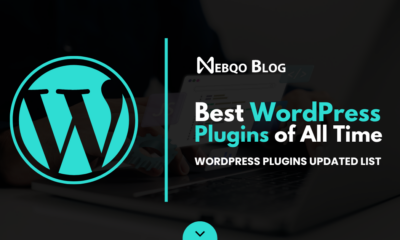TECHNOLOGY
5 Awesome Website Builders to Develop Optimized Business Websites

Web builders have become excessively popular in the past decade.

A website builder is a DIY tool that allows you to construct a website using pre-made templates, without writing any code. The website builder you choose for your business determines how your site looks and functions, what features you can include and other details like SEO and transaction fees.
Here is a list of 5 best website builders, with their pros, cons, and pricing. Browse the list and find the one that fits best for your business.
1. Wix
Wix.com is a very popular cloud-based website builder. It is best known for its user-friendly powerful set of features to easily build a modern and eye-catching website. Although Wix is suitable for all types and sizes of businesses, it is the best option for you if you have a start-up or small business willing to scale up.
Pros
- Wix website creator is a fully hosted platform.
- Get access to hundreds of templates to choose from.
- Intuitive drag and drop site builder.
- Offers business tools like Ascend by Wix, which includes a CRM, email marketing, automation, invoice generator and video maker.
- Design a beautiful website with help of Wix ADI.
- Dozens of free and paid apps that you can install on your website.
- Get a free SSL with all Wix plans.
Cons
- Free plans show Wix branded ads on your website.
- It is complicated to move your website away from Wix.
- The Connect Domain plan costs ?80 per month and you still have to buy a domain name separately.
- No ‘Live Chat’ option.
- To redesign with a new template you have to rebuild from scratch.
Pricing
Free Plan (best of testing your site)
Connect Domain: $80/month (billed annually)
Combo: $125/month (billed annually)
Unlimited: $185/month (billed annually)
VIP: $325/month (billed annually)
Business Basic: $225/month (billed annually)
Business Unlimited: $300/month (billed annually)
Business VIP: $500/month (billed annually)
2. Squarespace
Squarespace is another website builder that targets the niche of flexible customization options with an easy-to-use editor. It has been around since 2003 and millions of websites created on their platform. Though the designs offered by Squarespace are even more polished for better visuals, it is not for beginners.
Pros:
- Enterprise-grade infrastructure for hosting your website.
- Detailed onboarding process helps start you off.
- Great visuals and well-designed templates
- Google AMP
- Add coding with the Premium plan
- Mobile editor
- 24/7 customer support
- eCommerce plan allows you to add an online store to your website.
Cons:
- Offers limited integrations with third-party services
- eCommerce plans only allow Stripe, Apple Pay, and PayPal for payment processing.
- No backup and restore feature.
Pricing:
Personal: $12/month
Business: $18/month
Basic Commerce: $26/month
Advanced Commerce: $40/month
3. Weebly
Although it’s not exclusive to eCommerce, Weebly ranks as one of the best eCommerce website builders significantly. It offers more design options than your average basic website builder. Their content management system also easily supports large websites that count more than 150 pages.
Pros:
- Thorough onboarding is really helpful for beginners.
- Easy-to-use “drag and drop” interface.
- Responsive themes, adaptive to mobile devices.
- Built-in features for contact forms, photo galleries, sliders, and more.
- Inclusive package includes hosting and backend support.
- Social media integration.
- Helpful SEO guides and support center.
Cons:
- No third-party add-ons – get stuck with only what Weebly offers.
- Must upgrade to a paid account to remove advertising.
- Cannot hire a developer or designer to add new functionality or feature to your website.
- Charges 3% transaction fees on every purchase made through your eCommerce store.
Pricing:
- Connect: $5/month (when paid annually)
- Pro: $12/month (when paid annually)
- Business: $25/month (when paid annually)
4. GoDaddy
GoDaddy is known to be one of the largest domain names and hosting service providers, but it also has its own website builder. GoDaddy Websites and Marketing provides you with a toolkit to build your website and run your email marketing, social media, blogging, and SEO. With GoDaddy, you can build a website for free and access features such as a social media content creator, password-protected pages, and in-built analytics.
Pros
- Simple and easy tool to create professional-looking websites.
- Pre-loaded with ready-to-use blocks – drag and drop to build different layouts.
- Integrated photo library with professional images from Getty
- Upload your own photos and create image galleries.
- Works on smaller screens too.
Cons
- Lacks in some key SEO areas.
- Not as feature-rich and flexible as most other website builders.
- Offers a limited set of features with fewer design options.
- Quite difficult to move your website to WordPress.
Pricing
Basic: $9.99 /month (when billed annually)
Standard: $14.99/month (when billed annually)
Premium: $19.99/month (when billed annually)
Ecommerce: $24.99/ month (when billed annually)
5. WordPress
WordPress has been among the top website builders throughout the early 2010s, but the emergence of more user-friendly website builders like Wix and Squarespace has debased it somewhat. Yet, it remains competitive, powering 39.5% of all websites on the Internet with unique features, its unlimited plugin library, and its supreme blog-friendliness.
Pros:
- Free and open-source software.
- Very easy to get started
- Robust third-party plugins library.
- No maintenance or complex installation process.
- Tons of support and feedback and technical assistance from the community.
- Best website builder for blogs
- Option to use extra SEO plugins like Yoast
Cons:
- Not easy for beginners.
- Takes a big-time commitment.
- Too many limitations in place with each plan.
- All the best features (via plugins) cost extra.
Pricing:
Personal: $160/month (billed yearly)
Premium: $280/month (billed yearly)
Business: $640/month (billed yearly)
Ecommerce: $1152/month (billed yearly)
Conclusion
There are a lot of different website builders out there as per different business needs. Often people over-analyzing their website project and spend days comparing every little feature. We suggest you just sign-up for a free trial, to quickly check whether it is suitable for your business or not. Though, the most popular option overall is Wix. They’re a pretty dominant force in the website building business. Rest, it all depends on your use case.
TECHNOLOGY
Next-gen chips, Amazon Q, and speedy S3

AWS re:Invent, which has been taking place from November 27 and runs to December 1, has had its usual plethora of announcements: a total of 21 at time of print.
Perhaps not surprisingly, given the huge potential impact of generative AI – ChatGPT officially turns one year old today – a lot of focus has been on the AI side for AWS’ announcements, including a major partnership inked with NVIDIA across infrastructure, software, and services.
Yet there has been plenty more announced at the Las Vegas jamboree besides. Here, CloudTech rounds up the best of the rest:
Next-generation chips
This was the other major AI-focused announcement at re:Invent: the launch of two new chips, AWS Graviton4 and AWS Trainium2, for training and running AI and machine learning (ML) models, among other customer workloads. Graviton4 shapes up against its predecessor with 30% better compute performance, 50% more cores and 75% more memory bandwidth, while Trainium2 delivers up to four times faster training than before and will be able to be deployed in EC2 UltraClusters of up to 100,000 chips.
The EC2 UltraClusters are designed to ‘deliver the highest performance, most energy efficient AI model training infrastructure in the cloud’, as AWS puts it. With it, customers will be able to train large language models in ‘a fraction of the time’, as well as double energy efficiency.
As ever, AWS offers customers who are already utilising these tools. Databricks, Epic and SAP are among the companies cited as using the new AWS-designed chips.
Zero-ETL integrations
AWS announced new Amazon Aurora PostgreSQL, Amazon DynamoDB, and Amazon Relational Database Services (Amazon RDS) for MySQL integrations with Amazon Redshift, AWS’ cloud data warehouse. The zero-ETL integrations – eliminating the need to build ETL (extract, transform, load) data pipelines – make it easier to connect and analyse transactional data across various relational and non-relational databases in Amazon Redshift.
A simple example of how zero-ETL functions can be seen is in a hypothetical company which stores transactional data – time of transaction, items bought, where the transaction occurred – in a relational database, but use another analytics tool to analyse data in a non-relational database. To connect it all up, companies would previously have to construct ETL data pipelines which are a time and money sink.
The latest integrations “build on AWS’s zero-ETL foundation… so customers can quickly and easily connect all of their data, no matter where it lives,” the company said.
Amazon S3 Express One Zone
AWS announced the general availability of Amazon S3 Express One Zone, a new storage class purpose-built for customers’ most frequently-accessed data. Data access speed is up to 10 times faster and request costs up to 50% lower than standard S3. Companies can also opt to collocate their Amazon S3 Express One Zone data in the same availability zone as their compute resources.
Companies and partners who are using Amazon S3 Express One Zone include ChaosSearch, Cloudera, and Pinterest.
Amazon Q
A new product, and an interesting pivot, again with generative AI at its core. Amazon Q was announced as a ‘new type of generative AI-powered assistant’ which can be tailored to a customer’s business. “Customers can get fast, relevant answers to pressing questions, generate content, and take actions – all informed by a customer’s information repositories, code, and enterprise systems,” AWS added. The service also can assist companies building on AWS, as well as companies using AWS applications for business intelligence, contact centres, and supply chain management.
Customers cited as early adopters include Accenture, BMW and Wunderkind.
Want to learn more about cybersecurity and the cloud from industry leaders? Check out Cyber Security & Cloud Expo taking place in Amsterdam, California, and London. Explore other upcoming enterprise technology events and webinars powered by TechForge here.
TECHNOLOGY
HCLTech and Cisco create collaborative hybrid workplaces

Digital comms specialist Cisco and global tech firm HCLTech have teamed up to launch Meeting-Rooms-as-a-Service (MRaaS).
Available on a subscription model, this solution modernises legacy meeting rooms and enables users to join meetings from any meeting solution provider using Webex devices.
The MRaaS solution helps enterprises simplify the design, implementation and maintenance of integrated meeting rooms, enabling seamless collaboration for their globally distributed hybrid workforces.
Rakshit Ghura, senior VP and Global head of digital workplace services, HCLTech, said: “MRaaS combines our consulting and managed services expertise with Cisco’s proficiency in Webex devices to change the way employees conceptualise, organise and interact in a collaborative environment for a modern hybrid work model.
“The common vision of our partnership is to elevate the collaboration experience at work and drive productivity through modern meeting rooms.”
Alexandra Zagury, VP of partner managed and as-a-Service Sales at Cisco, said: “Our partnership with HCLTech helps our clients transform their offices through cost-effective managed services that support the ongoing evolution of workspaces.
“As we reimagine the modern office, we are making it easier to support collaboration and productivity among workers, whether they are in the office or elsewhere.”
Cisco’s Webex collaboration devices harness the power of artificial intelligence to offer intuitive, seamless collaboration experiences, enabling meeting rooms with smart features such as meeting zones, intelligent people framing, optimised attendee audio and background noise removal, among others.
Want to learn more about cybersecurity and the cloud from industry leaders? Check out Cyber Security & Cloud Expo taking place in Amsterdam, California, and London. Explore other upcoming enterprise technology events and webinars powered by TechForge here.
TECHNOLOGY
Canonical releases low-touch private cloud MicroCloud

Canonical has announced the general availability of MicroCloud, a low-touch, open source cloud solution. MicroCloud is part of Canonical’s growing cloud infrastructure portfolio.
It is purpose-built for scalable clusters and edge deployments for all types of enterprises. It is designed with simplicity, security and automation in mind, minimising the time and effort to both deploy and maintain it. Conveniently, enterprise support for MicroCloud is offered as part of Canonical’s Ubuntu Pro subscription, with several support tiers available, and priced per node.
MicroClouds are optimised for repeatable and reliable remote deployments. A single command initiates the orchestration and clustering of various components with minimal involvement by the user, resulting in a fully functional cloud within minutes. This simplified deployment process significantly reduces the barrier to entry, putting a production-grade cloud at everyone’s fingertips.
Juan Manuel Ventura, head of architectures & technologies at Spindox, said: “Cloud computing is not only about technology, it’s the beating heart of any modern industrial transformation, driving agility and innovation. Our mission is to provide our customers with the most effective ways to innovate and bring value; having a complexity-free cloud infrastructure is one important piece of that puzzle. With MicroCloud, the focus shifts away from struggling with cloud operations to solving real business challenges” says
In addition to seamless deployment, MicroCloud prioritises security and ease of maintenance. All MicroCloud components are built with strict confinement for increased security, with over-the-air transactional updates that preserve data and roll back on errors automatically. Upgrades to newer versions are handled automatically and without downtime, with the mechanisms to hold or schedule them as needed.
With this approach, MicroCloud caters to both on-premise clouds but also edge deployments at remote locations, allowing organisations to use the same infrastructure primitives and services wherever they are needed. It is suitable for business-in-branch office locations or industrial use inside a factory, as well as distributed locations where the focus is on replicability and unattended operations.
Cedric Gegout, VP of product at Canonical, said: “As data becomes more distributed, the infrastructure has to follow. Cloud computing is now distributed, spanning across data centres, far and near edge computing appliances. MicroCloud is our answer to that.
“By packaging known infrastructure primitives in a portable and unattended way, we are delivering a simpler, more prescriptive cloud experience that makes zero-ops a reality for many Industries.“
MicroCloud’s lightweight architecture makes it usable on both commodity and high-end hardware, with several ways to further reduce its footprint depending on your workload needs. In addition to the standard Ubuntu Server or Desktop, MicroClouds can be run on Ubuntu Core – a lightweight OS optimised for the edge. With Ubuntu Core, MicroClouds are a perfect solution for far-edge locations with limited computing capabilities. Users can choose to run their workloads using Kubernetes or via system containers. System containers based on LXD behave similarly to traditional VMs but consume fewer resources while providing bare-metal performance.
Coupled with Canonical’s Ubuntu Pro + Support subscription, MicroCloud users can benefit from an enterprise-grade open source cloud solution that is fully supported and with better economics. An Ubuntu Pro subscription offers security maintenance for the broadest collection of open-source software available from a single vendor today. It covers over 30k packages with a consistent security maintenance commitment, and additional features such as kernel livepatch, systems management at scale, certified compliance and hardening profiles enabling easy adoption for enterprises. With per-node pricing and no hidden fees, customers can rest assured that their environment is secure and supported without the expensive price tag typically associated with cloud solutions.
Want to learn more about cybersecurity and the cloud from industry leaders? Check out Cyber Security & Cloud Expo taking place in Amsterdam, California, and London. Explore other upcoming enterprise technology events and webinars powered by TechForge here.
-

 SEO7 days ago
SEO7 days agoHow to Use Keywords for SEO: The Complete Beginner’s Guide
-

 MARKETING5 days ago
MARKETING5 days agoAdvertising on Hulu: Ad Formats, Examples & Tips
-

 MARKETING2 days ago
MARKETING2 days ago18 Events and Conferences for Black Entrepreneurs in 2024
-

 WORDPRESS5 days ago
WORDPRESS5 days agoBest WordPress Plugins of All Time: Updated List for 2024
-

 MARKETING6 days ago
MARKETING6 days agoUpdates to data build service for better developer experiences
-

 MARKETING7 days ago
MARKETING7 days agoThe Ultimate Guide to Email Marketing
-

 WORDPRESS6 days ago
WORDPRESS6 days agoShopify Could Be Undervalued Based On A Long-Term Horizon
-

 PPC6 days ago
PPC6 days agoLow Risk, High Reward YouTube Ads alexking













